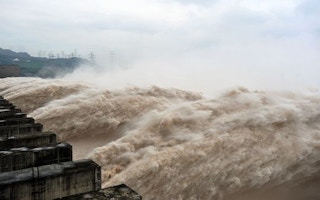The company that displaced 1.2 million people to build the world’s largest dam in China has been given permission to build Southeast Asia’s largest dam in Shan State, in partnership with a company owned by the son of a former minister, deputy minister of electric power Maw Thar Htwe said.
The Ministry of Electric Power has granted permission to IGE Company and China Three Gorges Corporation to construct the dam on the Thanlwin River, deputy minister of electric power Maw Thar Htwe told Parliament on September 16.
He was responding to a question from Lower House MP Nan Wah Nu, who represents Kunhein constituency in Shan State, about the planned 7,000-megawatt Mongton hydropower project.
Maw Thar Htwe said both companies would hold discussions with local communities about the environmental and social impacts of the project. “They also plan to discuss possible advantages and disadvantages with local people, and their views will be taken into consideration,” the deputy minister added.
He said about 262 square miles of low-lying area would be affected by the hydropower project in Mongton Township.
“
We estimate that half of the 245 large dams we’ve studied are nonviable, meaning they won’t be able to redeem the cost of building them
Bent Flyvbjerg, economic geographer, Oxford University
A feasibility study on the project has already been conducted, Maw Thar Htwe said, adding that it had been submitted last year and that foreign consultants would be hired to assess it. If they deem that the project is feasible thorough studies of the project’s environmental and social impacts will be made and detailed findings will be submitted, he added.
A source, however, told Eleven Media that the Ministry of Environmental Conservation and Forestry had already selected Australian-based Snowy Mountain Engineering Corporation to compile a report on the project’s environmental and social impacts.
The company has previously worked in Myanmar’s hydropower sector. It says it provided a range of services for the controversial Ta Sang Hydropower Project on the Than Lwin River in southern Shan State. That project was never completed. Shan advocacy groups and environmentalists have described the Mongton hydropower project as the Ta Sang’s latest incarnation.
Nan Wah Nu told Parliament that residents in the project area are alarmed about the environmental damage the dam will cause, as well as the direct impacts it will have on their lives. It will affect residents of low-lying areas from Kunhein Township to Tawkaw Bridge, he said, adding that people who live along the Thanlwin River are very concerned about dams.
The dam, also known as the Upstream Thanlwin hydropower project will have a capacity to generate 7,000 MW, or 34,717 kilowatt-hours, a year.
Maw Thar Htwe said that the cost of the project could not be estimated before its feasibility study is examined and approved. The project’s profitability could not be estimated either, he added. He said that all electricity generated from the project would be for domestic consumption and only surplus electricity would be sold to neighbouring countries.
Nay Aung, the son of former minister of industry-1 Aung Thaung, owns IGE Company. It acquired permission from the government to build eight hydropower projects in partnership with Chinese companies. The 7,000 MW Mongton, 1,360 MW Hatgyi and 1,200 MW Naungpha projects are among the eight the company plans to build.
According to the MoU on projects to be implemented on Nawchankha River, IGE will receive 2 per cent of the profits, its Chinese partner 83 per cent and the government 15 per cent.
The Mongton project is the second planned for the Thanlwin River. The first is the upstream Thanlwin (Kwunlon) project, which will be built by Asia World Company and China’s Hanergy Group Holding Limited. The contract for that project was signed during the third week of May this year. It will generate 1,400 MW, with 10-15 per cent of this going to Myanmar and the rest to China.
State-owned China Three Gorges Corporation built the Three Gorges Dam, the largest dam in the world. It is notorious for displacing more than 1.2 million people. It flooded 13 cities, 140 townships and 1,350 villages, and caused massive environmental damage that environmentalists say will worsen in the future.
A survey of 245 dams in 65 countries by an Oxford University economic geographer Bent Flyvbjerg concluded that their average cost and schedule overruns were 96 and 44 per cent, respectively.
“We estimate that half of the 245 large dams we’ve studied are nonviable, meaning they won’t be able to redeem the cost of building them,” Flyvbjerg told Bloomberg Businessweek. The danger of contractors cutting corners on construction to save costs is higher in developing countries, which increases the likelihood of more severe environmental damage, the study found.
It also found that power generation fell short of estimates. A seminar at the office of the Union of Myanmar Federation of Chambers of Commerce and Industry on February 11 outlined possible impacts that should be taken into consideration if large dams are built on rivers in Myanmar. Most attendees agreed that these projects should not proceed.
Hydropower projects in Myanmar are shrouded in mist, with few details on profit sharing, environmental impacts and returns on investment released in advance, critics of the projects say. Contracts lacking transparency are increasing as swiftly as plans to build more and more dams on the nation’s rivers arise, they say.

















